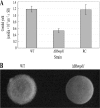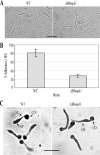Requirement of a mitogen-activated protein kinase for appressorium formation and penetration of insect cuticle by the entomopathogenic fungus Beauveria bassiana
- PMID: 20139313
- PMCID: PMC2849248
- DOI: 10.1128/AEM.02246-09
Requirement of a mitogen-activated protein kinase for appressorium formation and penetration of insect cuticle by the entomopathogenic fungus Beauveria bassiana
Erratum in
-
Correction for Zhang et al., "Requirement of a Mitogen-Activated Protein Kinase for Appressorium Formation and Penetration of Insect Cuticle by the Entomopathogenic Fungus Beauveria bassiana".Appl Environ Microbiol. 2023 Nov 29;89(11):e0154323. doi: 10.1128/aem.01543-23. Epub 2023 Oct 26. Appl Environ Microbiol. 2023. PMID: 37882536 Free PMC article. No abstract available.
Abstract
Beauveria bassiana is an important insect-pathogenic fungus that invades insects by direct penetration of the host cuticle. To delineate the molecular mechanisms involved in fungal infection, a mitogen-activated protein kinase (MAPK) gene, Bbmpk1, which encodes a YERK1 family MAPK was isolated and characterized. Targeted gene disruption of Bbmpk1 resulted in a complete loss of virulence when applied topically to host insects but did not affect growth of the fungus when conidia were injected directly into the hemocoel. Hyphae of the mutant strain growing in the insect hemocoel were unable to penetrate the cuticle growing outwards and consequently failed to sporulate on the cadaver surface. These data suggest that BbMPK1 is essential for penetration of the insect cuticle both from the outside and from the inside-out in order to escape and disperse from the host. Inactivation of BbMPK1 also caused a significant decrease in fungal adhesion to insect cuticles and eliminated their ability to form appressoria. In order to identify downstream genes regulated by BbMPK1, a suppressive subtractive hybridization (SSH) library was generated comparing mutant and wild-type transcripts isolated during appressorium formation. Thirty-one genes screened from the SSH library were determined to be expressed in the wild-type strain but either significantly reduced or not expressed in the mutant. Ten genes showed high or medium similarity to known protein encoding genes, including proteins involved in cell surface hydrophobicity, lipid metabolism, microtubule dynamics, mitochondrial electron transport, chromatin remodeling, transcription, rRNA processing, small nucleolar RNA accumulation, oxidation of aldehydes, translation, and likely other cellular processes.
Figures




References
-
- Bidochka, M., and G. G. Khachatourians. 1990. Identification of Beauveria bassiana extracellular protease as a virulence factor in pathogenicity toward the migratory grasshopper, Melanoplus sanguinipes. J. Invertebr. Pathol. 56:362-370.
-
- Cho, E. M., B. H. Kirkland, D. J. Holder, and N. O. Keyhani. 2007. Phage display cDNA cloning and expression analysis of hydrophobins from the entomopathogenic fungus Beauveria (Cordyceps) bassiana. Microbiology 153:3438-3447. - PubMed
-
- Cho, Y., R. A. Cramer, K. H. Kim, J. Davis, T. K. Mitchell, P. Figuli, B. M. Pryor, E. Lemasters, and C. B. Lawrence. 2007. The Fus3/Kss1 MAP kinase homolog Amk1 regulates the expression of genes encoding hydrolytic enzymes in Alternaria brassicicola. Fungal Genet. Biol. 44:543-553. - PubMed
-
- Clarkson, J. M., and A. K. Charnley. 1996. New insights into the mechanisms of fungal pathogenesis in insect. Trends Microbiol. 4:197-203. - PubMed
-
- de Jong, J. C., B. J. McCormack, N. Smirnoff, and N. J. Talbot. 1997. Glycerol generates turgor in rice blast. Nature 389:244-245.
Publication types
MeSH terms
Substances
Associated data
- Actions
- Actions
LinkOut - more resources
Full Text Sources

